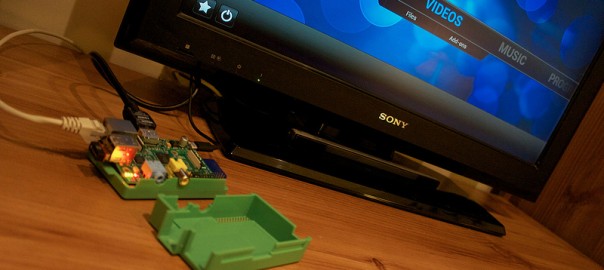Using Raspberry Pi and XBMC to build an ultra-cheap HTPC.

Back in 2006/7 I used to use XBox Media Center (XBMC) on my original XBox to play films and show pictures on our television. Since then XBMC has become a cross-platform homebrew juggernaut, available for almost every platform. And that now includes the Raspberry Pi, a low-cost device to stimulate interest in Computer Science.
I’m not going to wax lyrical about my computing history, but suffice to say I’ve spent a decent amount of time looking for the perfect Home Theatre PC (HTPC) setup. At the moment we’re using a PlayStation 3 with the PlayTV accessory. It’s a great, easy-to-use (and visually appealing) solution, but a proprietary one that uses a fair amount of power. The Raspberry Pi on the other hand can be powered from the USB port on my television whilst outputting silky-smooth 1080p video. Amazing.
With every week that passes it seems that it’s possible to do ever more with a XBMC-powered Raspberry Pi but, at the moment, here’s what I’m using mine for:
- Streaming videos from our Network Attached Storage (NAS) drive
- Playing photos, videos and music (including Spotify) from our iPad via Airplay
- Catching up with BBC iPlayer (as well as catch-up services from other channels)
Given that there’s free XBMC apps for both iOS and Android devices navigation via wifi on a tablet or phone is a breeze. It feels like using a much more expensive device.
How to get started
If you want to do what I’ve done then it couldn’t really be much easier:
- Buy a Raspberry Pi (and a case, if you want one)
- Find an SD card (2GB is plenty big enough)
- Use a Mac and XPi installer
- Put the SD card in the Raspberry Pi
- Hook the Raspberry Pi up to power and a screen
- Enjoy!
- (optional) Follow some of the advice here and install add-ons not in the built-in repository (such as BBC iPlayer)
Bingo.

Many thanks for posting these steps Doug. I’ve finally got a reason to open that Raspberry Pi in the corner now 😉
Excellent! Let me know how you get on 🙂
Do you experience any lag? I know there’s a team that ported xmbc over for the Pi, but I heard it still had issues.
It’s pretty smooth. The pinch point in my house is the wifi network, not the RPi!
How do you foresee Pi being used in the classroom? What is the educational value of getting XBMC running on Pi versus some generic laptop?
Good question with (at least) three answers:
1. It frees up the the teacher’s laptop
2. It’s less likely to break or overheat
3; it does 1080p video
I’d have one in my classroom!